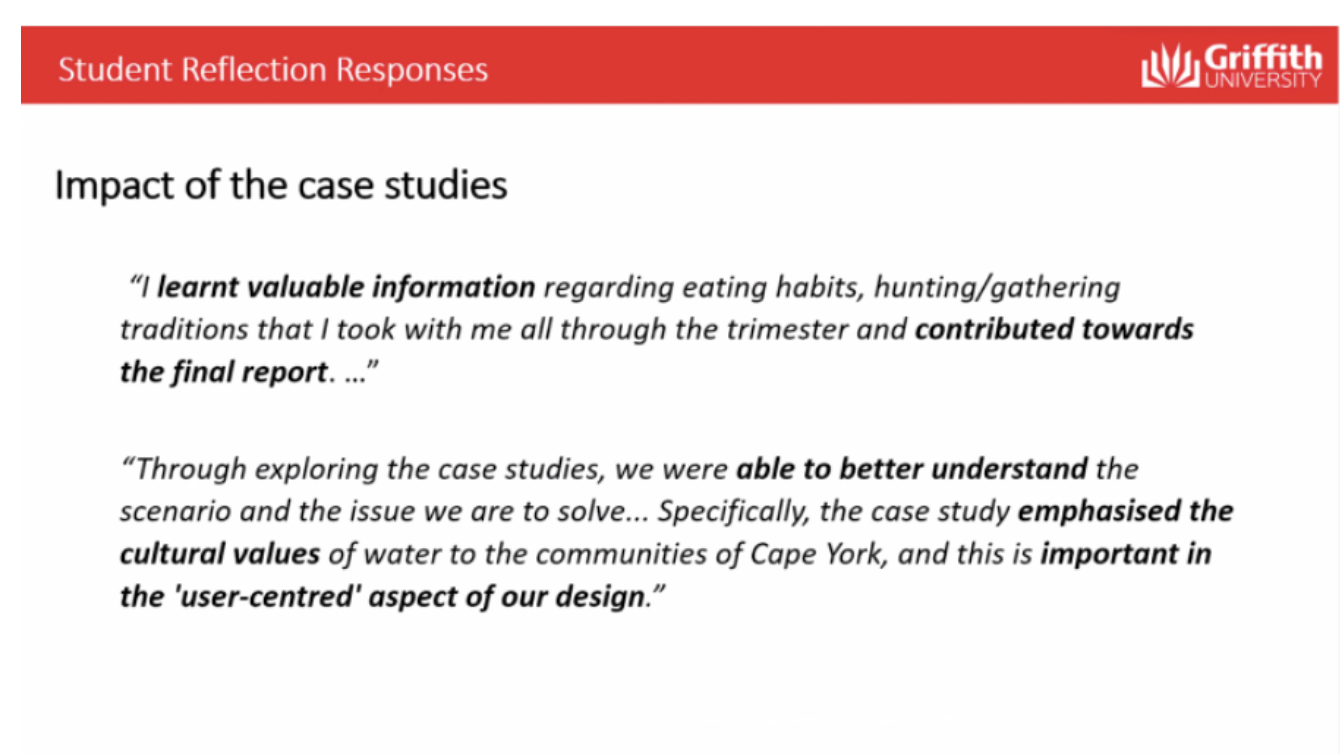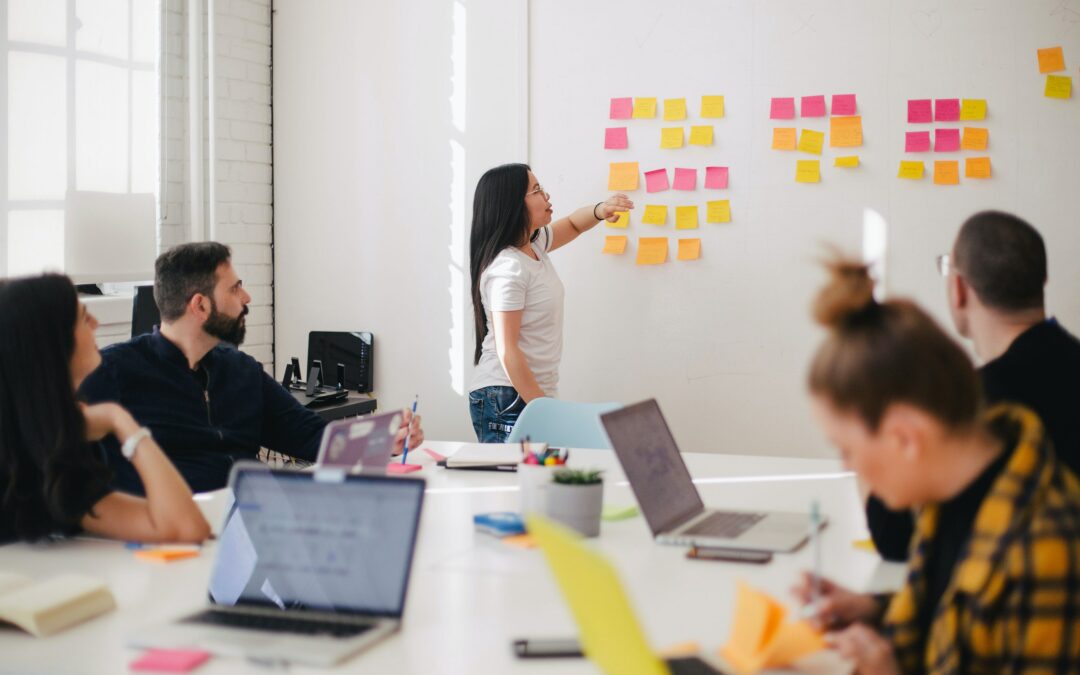The academic team at Griffith University has been working to authentically embed Indigenous perspectives into their engineering and design curriculum. This begins in a student’s first year at Griffith University with the EWB Challenge program, which introduces students to the importance of socially and culturally-aware design solutions. This program served as a catalyst for Griffith University to further explore and engage both students and academics more deeply with Indigenous perspectives.
Griffith University acknowledges that we are all living, learning and working on Stolen Land, and as such, reconciliation needs to be at the heart of everything they do. They recognise the importance of both students and academics alike expanding their worldview and knowledge of Indigenous perspectives. At Griffith University, Indigenous perspectives are not just introduced through a one-off lecture or module; they are meaningfully included in all aspects of the curriculum.
Integrating Indigenous perspectives meaningfully requires skilled and knowledgeable academics committed to the authentic integration of these perspectives into the engineering and design curriculum. One such academic is Jennifer Campbell. Jennifer is a proud Aboriginal woman and Lecturer, working with Griffith University at the School of Engineering and Built Environment. Jennifer is passionate about bringing together culture and engineering, stating that it’s important to acknowledge “Aboriginal and Torres Strait Islander Peoples as the first engineers…[who] have been engineering this landscape for a very long time.” Jennifer wants students to learn that including and understanding Indigenous perspectives is not only important, but ultimately leads to better design solutions.
In order to solve the many problems that the world is facing, it’s crucial that future engineers are able to create user-centred and fit-for-purpose design solutions that meaningfully reflect thousands of years of Indigenous engineering knowledge and perspectives. At Griffith University, students are taught to understand that a good design solution is designed with, and not for, community. The importance of this partnership is emphasised throughout the course, with students given many opportunities to explore, reflect and discuss Indigenous perspectives.
We are all learning
Griffith University is passionate about creating a learning environment that is built on mutual respect and trust. Dr Ruby Michael, an academic at Griffith University, believes that one of the best ways to help students and academics build confidence in engaging with Indigenous perspectives is to remind them that “we are all learning”. Moving away from the traditional hierarchical teaching model and towards a collaborative learning experience helps to create a safe, reflective learning environment, where students feel supported to build their cultural competency. Dr Michael believes that encouraging Indigenous perspectives so early on in the course is beneficial for first-year students who are still building their identities as engineers. Such discussions enrich their worldview, giving them important foundational skills and knowledge that they can come back to as they progress through their studies. Dr Michael states that the case studies explored in the Cape York EWB Challenge helped to provide moments for staff and students alike to reflect on their cultural competency, and actually served as a catalyst for Griffith University to further explore and engage with Indigenous perspectives.
How do you embed Indigenous perspectives?
In 2020, academics from Griffith University led a research study that outlined the practical ways that Indigenous perspectives can be embedded into an engineering curriculum. The research utilised the EWB Challenge’s Cape York homelands and outstations context and partnered with the Centre for Appropriate Technology. The research found that a combination of in-studio discussions, presentations, real-world case studies, industry engagement and discussions with Indigenous people, helped to introduce first-year students to new world-views and ways of thinking. The practical elements, combined with critical reflection and self-assessment, were important tools that helped to build students’ knowledge of Indigenous perspectives. Students have reported feeling an increase in their cultural competency, with one student attributing this to the safe learning environment which fostered a persistent sense of “eagerness and curiosity” within them.
Further to this, the research found that the EWB Challenge was an important vessel for students to be introduced to Indigenous Knowledge and Perspectives on engineering. The EWB Challenge helps students to build cultural competency from quite early on in their studies, and to learn how social and cultural factors influence the design process, introducing them to the many social, cultural and environmental responsibilities of an engineer.
This research further highlighted how the EWB Challenge program can enable students to develop their engineering competencies, beyond the academic and technical side of their learning. Through the case studies that form part of the content of the EWB Challenge, students develop key competencies by considering how social, environmental and cultural factors influence the design process. The case studies presented in the Cape York EWB Challenge introduce historical and current examples of Indigenous engineering. These case studies help to open their minds to new perspectives and introduce them to the importance of user-centred design.

A snapshot of some student reflections, provided by Griffith University
By embedding Indigenous perspectives into the engineering curriculum, emerging engineers are encouraged to be culturally conscious and to take a community-centred approach to their design solutions. To address the Sustainable Development Goals, it’s essential that engineers develop skills to create collaborative relationships with communities.
Building academic confidence
Universities are actively shaping future engineering communities. In order to tackle pressing global issues like food insecurity and climate change, it’s crucial that all universities work to integrate the perspectives of Aboriginal and Torres Strait Islander peoples. The research from Griffith University serves as a great resource, providing educators with many practical ways to meaningfully embed Indigenous perspectives into their curriculum. EWB is committed to supporting academics to introduce Indigenous perspectives into their curriculum, because there is no technology that benefits all without reconciliation first.
You can find out more about the EWB Challenge here.
This article is produced as part of our RAP commitment to communicating our learnings and sharing case studies from implementing our RAP.



